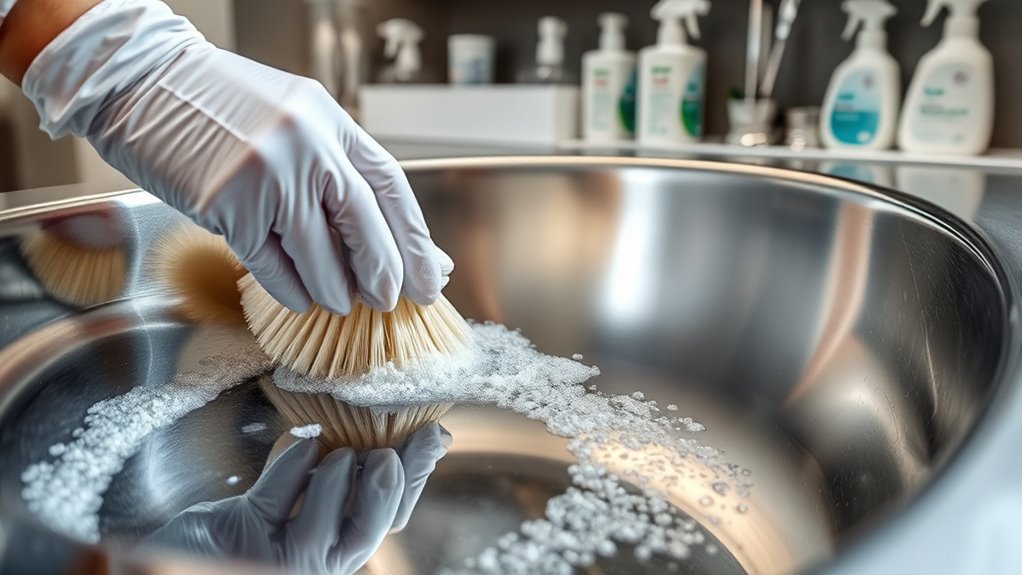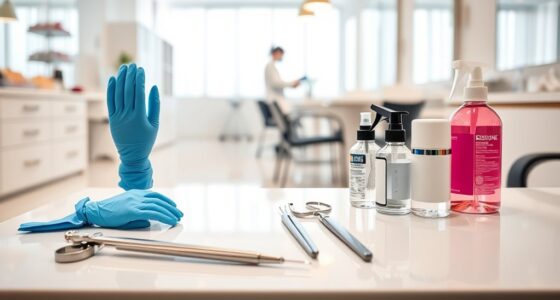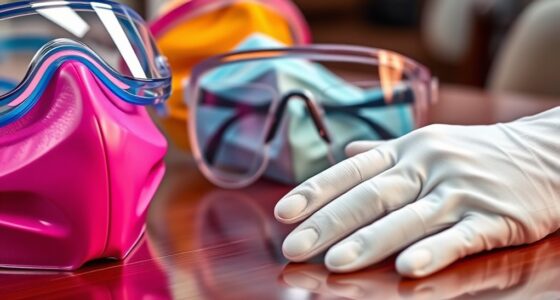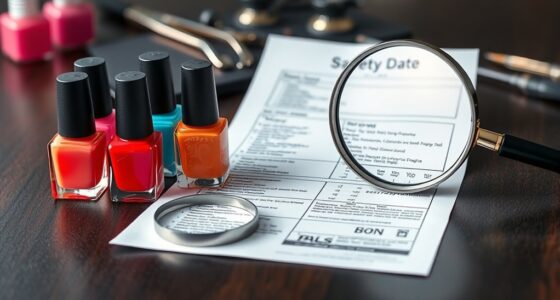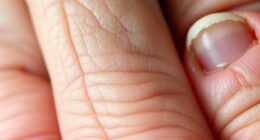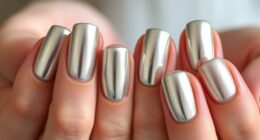To sanitize pedicure tubs properly, you start by draining and rinsing with water to remove debris. Then, apply a hospital-grade disinfectant, following the manufacturer’s instructions, and let it sit for the recommended contact time. Rinse again to clear residues. Afterward, dry thoroughly with a clean towel. For extra safety, run a UV sterilizer to kill remaining microorganisms. Continuing with these steps will guarantee a thorough, safe sanitation process in your practice.
Key Takeaways
- Drain the tub and rinse thoroughly with water to remove debris before disinfecting.
- Apply a hospital-grade disinfectant according to manufacturer instructions and let it sit for the recommended contact time.
- Use UV sterilization after chemical disinfection to eliminate remaining microorganisms effectively.
- Dry the tub completely with a clean, disposable towel to prevent microbial growth and water spots.
- Maintain equipment, document cleaning procedures, and train staff regularly for consistent, effective sanitation.
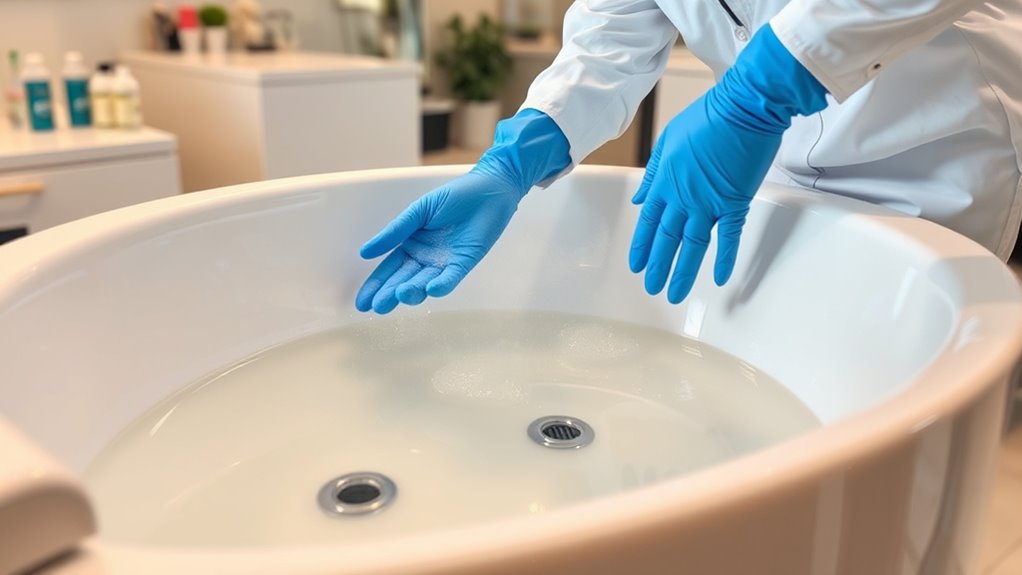
Properly sanitizing pedicure tubs is essential to guarantee a safe and hygienic experience for clients. One of the most effective methods involves using UV sterilization, which destroys bacteria, viruses, and fungi through ultraviolet light exposure. UV sterilizers are easy to integrate into your cleaning routine; simply run the device after each use to ensure pathogens are eliminated without chemical residues. However, UV sterilization alone isn’t enough. You should also incorporate chemical disinfectants, which are crucial for a thorough clean. After draining the tub, rinse it with water to remove any debris or residue. Then, apply a hospital-grade disinfectant, following the manufacturer’s instructions. These disinfectants are designed to kill a wide range of microorganisms, providing an extra layer of protection. It’s important to let the disinfectant sit for the recommended contact time to ensure maximum efficacy. Once the disinfectant has done its job, rinse the tub again with clean water to remove any chemical residues that could irritate clients’ skin or interfere with subsequent sterilization steps. Additionally, understanding the importance of attention in creative practice can help you focus better during each step, ensuring no detail is overlooked in your sanitation process.
Next, dry the tub thoroughly with a clean, disposable towel or cloth. Proper drying prevents water spots and inhibits microbial growth that can thrive in moist environments. After the physical cleaning and disinfection steps, you can use UV sterilization to further sanitize the tub. Many modern UV sterilizers are designed specifically for pedicure equipment and are simple to operate. Just place the tub inside, turn on the device, and let it run for the recommended duration. This step helps kill any remaining microorganisms that might have survived chemical disinfectants, ensuring a comprehensive sanitation process. Remember, UV sterilization is a supplement—not a replacement—for chemical disinfectants. Combining both methods guarantees a higher level of cleanliness, reducing the risk of cross-contamination.
Finally, keep detailed records of your cleaning and sterilization procedures, especially if your state or local health department requires documentation. Regularly check and maintain your UV sterilizers and disinfectant supplies to ensure they are functioning correctly. Train your staff thoroughly on these procedures to keep the sanitation process consistent and effective. By diligently following these steps and integrating UV sterilization with chemical disinfectants, you create a safer environment for your clients and protect your reputation as a professional. Properly sanitized pedicure tubs are a vital part of your overall hygiene protocol, helping prevent the spread of infections and maintaining trust in your services.
Frequently Asked Questions
How Often Should Pedicure Tubs Be Sanitized?
You should sanitize your pedicure tub after each client to guarantee proper pedicure tub maintenance. Regular sanitation frequency helps prevent bacteria buildup and cross-contamination. Daily cleaning is essential, especially if the tub is used multiple times a day. By maintaining a consistent sanitation schedule, you keep the environment safe and hygienic. Remember, frequent cleaning not only protects clients but also prolongs the lifespan of your equipment.
What Disinfectants Are Safest for Pedicure Tubs?
When choosing disinfectant types for pedicure tubs, safety is key. You should opt for EPA-registered disinfectants labeled safe for salon use, such as quaternary ammonium compounds or sodium hypochlorite solutions. Always follow safety precautions by wearing gloves and ensuring proper ventilation. Read label instructions carefully, and never mix disinfectants. This approach guarantees effective sanitation while protecting your clients and staff from harmful chemicals.
Can Homemade Solutions Effectively Sanitize Pedicure Tubs?
You might wonder if homemade disinfectants can effectively sanitize pedicure tubs. While some homemade disinfectants, like diluted bleach or vinegar solutions, can reduce germs, they often aren’t as reliable as commercial disinfectants. For effective cleaning solutions, it’s best to use proven disinfectants designed for sanitation. Relying solely on homemade disinfectants may leave bacteria behind, so always follow up with proper cleaning methods to guarantee safety and hygiene.
How Do I Prevent Mold Buildup in Pedicure Tubs?
To prevent mold buildup in pedicure tubs, you should focus on proper tub maintenance and mold prevention techniques. After each use, rinse the tub thoroughly and dry it completely to eliminate moisture. Regularly clean and disinfect the tub with an effective solution. Keep the area well-ventilated to prevent humidity. By maintaining a consistent cleaning routine and monitoring for moisture, you’ll reduce the risk of mold growth and keep your tub hygienic.
Are There Eco-Friendly Sanitizing Options Available?
Did you know that over 75% of consumers prefer eco-friendly products? You can find eco-friendly sanitizing options like biodegradable cleaners and natural disinfectants that are effective while being gentle on the environment. These alternatives help reduce chemical exposure and pollution, making your pedicure tubs safer for clients and the planet. By choosing these options, you’re supporting sustainable practices without sacrificing cleanliness or hygiene.
Conclusion
Properly sanitizing pedicure tubs is essential for client safety and your reputation. By following these simple steps, you guarantee a hygienic environment every time. Did you know that according to the CDC, proper cleaning and disinfection can reduce the risk of infection transmission by up to 99%? Staying diligent with your sanitizing routine not only protects your clients but also boosts your business’s credibility. Keep your tubs spotless, and your clients will keep coming back!
